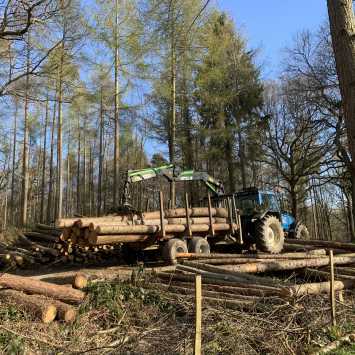Prior to the lockdown on March, 23rd Coronovirus seemed a distant problem and we were carrying on with our training programme, albeit with appropriate adjustments – indeed these adjustments were a discussion point during our City & Guilds Assessment Centre Audit carried out by Sally Crickmore during a Brushcutter ITA course.
After abandoning a 5-day climbing course on the 23rd we were in a state of disbelief and shock, this soon turned to a more useful gathering of ideas and planning. Interestingly, I started this lockdown wishing we were a more diverse business but ended it realising that we are more diverse than I first thought – a familiar change in perspective experienced by many during this time.
Running numerous small tree felling courses and a few over 380mm ones too meant our supplementary site at the Woodland Enterprise Centre in Flimwell (WEC) was full of material that needed to be brought out to roadside and sold. This seemed a reasonable fit with the lockdown rules as it could be considered essential on the basis of wood fuel into the energy supply chain, as well as being a solitary machine-based operation.
We’ve been working with Nick Meech and Jamie Kirkman, one of the WEL Directors, at the Woodland Enterprise Centre for a couple of years now, and had agreed to take on the management of the 45 acres or so of woodland that had been previously done on an ad-hoc basis by a local College. The first block we tackled was predominately larch & birch with some sweet chestnut to the east of the WEC building. It was all in need of a thin and some ride edge widening. More recently a block of chestnut coppice to the north of the building has been completed, bringing a welcome increase to the light reaching and views from/to the WEC building. Lastly, we have moved onto a difficult block of chestnut coppice to the northeast of the site, this is sloping and has a lot of historic and recent windblown trees.
Some extraction had been completed in the first larch block during a handy dry winter last year, but the area to the north of the WEC was full of cordwood and I spent 5 days working with our Valtra 6400 and Botex 570B Timber trailer to clear it.
Previously at the WEC and at our main site in Lamberhurst, we have used a two-stage approach to timber extraction –
- Firstly consolidate material with our 5ton Takeuchi 360 excavator fitted with rotating timber grapple – also great to find and minimize tractor stopping obstacles.
- Then extract on more straightforward established routes using tractor and timber trailer
This was my plan before the lockdown and it does work well especially with our mix of staff variable in their experienced in timber extraction. It results in fewer breakages but lower output. However, to save on haulage costs on the digger, I decided to work solely with the tractor and trailer unit, in line with how I originally learned. (This was in a much less capable set up of a Zetor 4x4 tractor and non-extending boom trailer with a decreasing slew power as the hydraulic oil heated up).
The material layout is the key at the felling stage to the ease of subsequent handling and removal of felled trees, this is covered in the City & Guilds cross-cutting unit 202 where grading and presentation for extraction are mentioned. Ideally, students should:
- Think about extraction routes before and when tree felling
- Avoid stacking on such routes where possible or keep to the sides
- Stack in neat groups of like material
- Minimise movement of heavy logs
- Avoid brash stacking on extraction routes, or cut to waste to protect the soil
- Cut stumps low and make sure they are not hidden to avoid tyre damage
During our tree felling courses, the above points are covered and often reinforced with integrated machine use. I work the site from convenient access points and various approaches can be used, such as creating circular routes around the compartment or working from the back towards the entrance filling up whilst moving forwards avoiding side slopes.
I often drive in forwards and move material to the left and right as our crane can reach to almost in front of the tractor front wheels, this way brash can be moved and material pre-sorted for subsequent runs. This allows lighter shorter cordwood to be moved first with the longer heavier sawlogs left until last, once routes have been tested and traction levels established. When a circular route can’t be developed this method sometimes forces a turn but with the steering drawbar on our trailer it’s possible to turn around in fairly tight spaces.
Options to market this material are many but we opted for the speedy collection offered by Euroforest for the lower value chip wood. They were able to move material at the roadside the same or next day making the most of our small stacking areas. This is transported to the biomass power station in Sandwich on the Kent coast. Larger larch was run back to our yard for sawmilling stock as well as higher grade chestnut for fencing orders.
With reasonable progress I moved onto the final northeast compartment and constructed a large windrow with the brash, hopefully, this will be good habitat and help define the compartment visually, whilst protecting regrowth from browsing damage. Although we were frustrated with the lockdown situation we had taken positive action and completed an important part of the overall cycle in coppice cutting. It had also generated some very welcome timber sale income.


